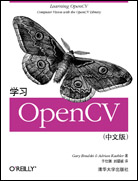
学习OpenCV(中文版)
于仕琪, 刘瑞祯 译
出版时间:2009年09月
透过本书,您将置身于迅速发展的计算机视觉领域。本书由自由开源OpenCV的发起人所著,介绍了计算机视觉,并通过实例演示了如何快速生成这样的应用——能使计算机“看到”并根据由此获取的数据做出决策。
计算机视觉无处不在,安全系统、制造检验系统、医学图像分析、无人机等都可以见到它的踪影。它与Google Map和Google Earth紧密结合,它检查LCD屏幕上的像素,它确保衬衫上的每个针脚都能完全缝合。OpenCV提供了一个简易好用的计算机视觉框架和一个丰富的库,后者包含500多个可实时运行视觉代码的函数。
透过各章提供的练习,任何一个开发人员或爱好者都可以迅速掌握这个框架的用法。本书特色主题如下:
● 透彻介绍OpenCV
● 从摄像机获取输入
● 图像的变换
● 图像的分割和形状的匹配
● 模式识别,包括人脸检测
● 二维和三维场景中的跟踪监测
● 根据立体视觉进行三维重构
● 机器学习算法
“让机器来看”是一个富有挑战但也很有意思的目标。不管是想构建简单的视觉应用,还是复杂的视觉应用,都离不开这本入门必备参考,拿起它,开始愉快的学习之旅吧!
“OpenCV库对从业人员而言非常有用,对初涉该领域的新手而言也不失为一个优秀工具。正如其广而告之的那样,它是一套高效的计算机视觉算法。”
——William T. Freeman,麻省理工学院计算机科学与人工智能实验室
“对计算机视觉领域内任何一个从业人员而言,《学习OpenCV(中文版)》是他们不可或缺的重要参考。”
——David Lowe
英属哥伦比亚大学计算机科学系教授
Gary Bradski博士是斯坦福大学人工智能实验室计算机科学系的顾问教授,同时也是Willow Garage的资深科学家,Willow Garage是一家机器人研究机构/孵化器。
Adrian Kaehler博士,Applied Minds公司的资深科学家,负责指导机器学习、统计建模、计算机视觉和机器人方面的研究。
计算机视觉无处不在,安全系统、制造检验系统、医学图像分析、无人机等都可以见到它的踪影。它与Google Map和Google Earth紧密结合,它检查LCD屏幕上的像素,它确保衬衫上的每个针脚都能完全缝合。OpenCV提供了一个简易好用的计算机视觉框架和一个丰富的库,后者包含500多个可实时运行视觉代码的函数。
透过各章提供的练习,任何一个开发人员或爱好者都可以迅速掌握这个框架的用法。本书特色主题如下:
● 透彻介绍OpenCV
● 从摄像机获取输入
● 图像的变换
● 图像的分割和形状的匹配
● 模式识别,包括人脸检测
● 二维和三维场景中的跟踪监测
● 根据立体视觉进行三维重构
● 机器学习算法
“让机器来看”是一个富有挑战但也很有意思的目标。不管是想构建简单的视觉应用,还是复杂的视觉应用,都离不开这本入门必备参考,拿起它,开始愉快的学习之旅吧!
“OpenCV库对从业人员而言非常有用,对初涉该领域的新手而言也不失为一个优秀工具。正如其广而告之的那样,它是一套高效的计算机视觉算法。”
——William T. Freeman,麻省理工学院计算机科学与人工智能实验室
“对计算机视觉领域内任何一个从业人员而言,《学习OpenCV(中文版)》是他们不可或缺的重要参考。”
——David Lowe
英属哥伦比亚大学计算机科学系教授
Gary Bradski博士是斯坦福大学人工智能实验室计算机科学系的顾问教授,同时也是Willow Garage的资深科学家,Willow Garage是一家机器人研究机构/孵化器。
Adrian Kaehler博士,Applied Minds公司的资深科学家,负责指导机器学习、统计建模、计算机视觉和机器人方面的研究。
书名:学习OpenCV(中文版)
作者:Gary Bradski, Adrian Kaehler 著
译者:于仕琪, 刘瑞祯 译
国内出版社:清华大学出版社
出版时间:2009年09月
书号:978-7-302-20993-5
原版书出版商:O'Reilly Media
购买选项